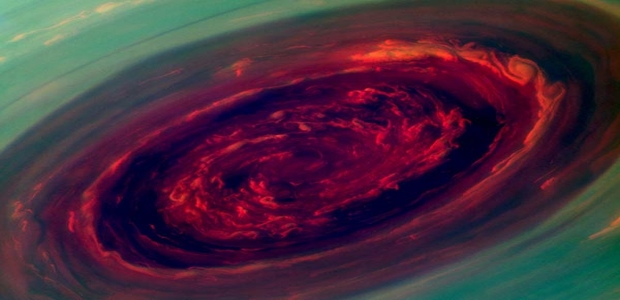Saturn has always been one of the most curiosity generating planets of our solar system and possibly one of the best looking planets due to its rings. In recent times this second largest planet of our solar system has been making news for a hurricane centred on its north pole, a “rain” of water ice from its rings, and digestive troubles in its interior. On April 29th, 2013 the Cassini imaging team released the dramatic false-colour view above, looking down at the planet’s North Pole.
The rose-like feature is a deep view into a giant hurricane, which sits centred in the “polar hexagon” of higher altitude cloud streams. Roughly two Earths across, the hexagon has been around at least since its discovery in 1981 by Voyager 2. It appears to be a fast-moving jet stream, though its stable, six-sided shape remains a mystery. The hurricane is a surprise. Its eye spans some 1,250 miles (2,000 km), 20 times larger than counterparts on Earth. Winds race around the outer edge at 330 miles (530 km) per hour. It’s unclear what’s driving it or how long it has existed. On Earth, hurricanes are powered by heat drawn from tropical ocean water. But there’s no ocean under the hurricane on Saturn, just more atmosphere. It probably survives on a rain-and-evaporation cycle involving just the small amount of water vapor in Saturn’s hydrogen atmosphere.
Closer to Saturn’s equator, another investigation finds evidence that water vapour from the rings is streaming into the top of the planet’s ionosphere. This was suspected for decades, especially after Cassini found in 2004 that the rings are immersed in a tenuous water “atmosphere.” James O’Donoghue and his colleagues describe (in the April 11th Nature) their infrared observations with the Keck I telescope, which revealed odd bright and dark bands at the middle latitudes of both hemispheres. These bands suggest that ionized water molecules from the rings travel down magnetic field lines into Saturn’s ionosphere, where they “quench” a certain infra-red emission that otherwise ought to arise. The effect is weakest at latitudes that map back along the magnetic field lines to the Cassini Division and the Colombo Gap, where icy ring particles are sparse.
Planetary scientists have long known that Saturn emits about 2.5 times as much heat as it receives from the Sun. What generates the extra energy? For decades, scientists supposed that helium might be settling downward through the planet’s hydrogen-rich interior, slowly “raining out” toward the core in the form of liquid droplets over the age of the solar system. These droplets would liberate gravitational energy as they descend. But Jeremy Leconte and Gilles Chabrier suggest in the April 21st Nature Geoscience that Saturn’s glow is leakage of heat still left over from the planet’s formation 4.6 billion years ago. They think that a deep layer of stagnant gas has bottled in lots of ancient heat, releasing it only slowly. While helium rainout likely still happens, the authors doubt that it can account for all of Saturn’s excess infrared mission. Jupiter and Neptune also radiate about 1.7 and 2.6 times as much heat as they receive from the Sun, respectively. Uranus, a curious planet in many ways, generates next to none.
Source: Article by J. Kelly Beatty for Sky and Telescope (August 2013)

































